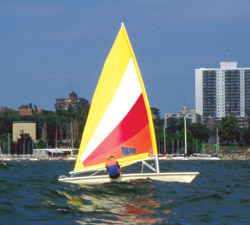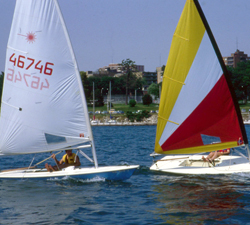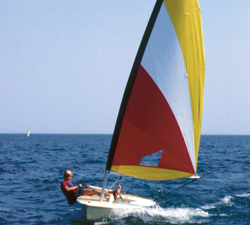Laser Radial
 The Laser Radial – A Canadian Evolution on the Back of Practical Experience
The Laser Radial – A Canadian Evolution on the Back of Practical Experience
As we look forward to the 2012 Olympics in London, two classes will be front and center: the Laser for Men and the Laser Radial for women. The Laser Radial might be, for some, a non-event, but for those who started to learn the sport for fun (and for racing), the Laser Radial was a monumental leap in design, taking a great concept and making it better. The “Laser” was brilliant at the time and still is today. Low cost, strict one design specifications, performance, both easy to rig and sail were all great features built around a two-section mast that slipped together for sailing but came apart easily for trailering or car topping. The Laser Radial evolution was brilliantly simple and based on experience and vision.
Anyone who has visited with Hans Fogh at home will no doubt remember a wonderful caricature that hangs proudly in the trophy room. This picture clearly illustrates the young Hans Fogh burdened with 25Kg of sweaters on his back relentlessly hiking in his Finn as he did so many times in so many races in the 1960s. To compete and win in the Finn, Fogh, like many others, needed the weight the water soaked sweaters would give him to keep his boat flat in the breezy conditions. He had to hike harder to balance the boat and get the speed upwind.
 Fast forward to the early 1970s & 1980s…Hans Fogh along with Ian Bruce and, of course, Bruce Kirby, worked hard together using their combined strengths in designing, building and sail/rig design to launch the Laser. And while that story is well known, the reality they faced over the first ten years of its great success was that a 90 kg (198 lb.) sailor had a huge advantage racing in certain conditions (10+ knots). Giving a huge advantage to larger framed sailors started to impede the Laser’s adoption as a true international class.
Fast forward to the early 1970s & 1980s…Hans Fogh along with Ian Bruce and, of course, Bruce Kirby, worked hard together using their combined strengths in designing, building and sail/rig design to launch the Laser. And while that story is well known, the reality they faced over the first ten years of its great success was that a 90 kg (198 lb.) sailor had a huge advantage racing in certain conditions (10+ knots). Giving a huge advantage to larger framed sailors started to impede the Laser’s adoption as a true international class.
What they wanted to get to was a solution that enabled them to use as much of what they had while being true to the Laser’s positioning as a low-cost performance one design class.
Many tried to help out the trio. But Steve Harstick’s brave attempt at designing the Laser M Rig was the first try. The goal: to design a smaller and therefore more easily handled sail plan/rig for the smaller sailor. Harstick’s solution used standard sailcloth in 3-foot panels with three battens (just like its bigger brother). He added a neat halyard set-up designed around a bigger sleeve allow easier raising and lowering of the sail. Sadly though, the results were not what Harstick wanted. The rig, based on a smaller top section with its lower aspect ratio (compared to the Laser) was hard to depower because of the resulting stiffness of the mast which occurred because of the use of the standard lower mast section and the larger sail panels.
 While this M Rig experiment continued, Hans Fogh’s son Morten was exiting the Optimist and, like his father, his lighter frame and lower weight could not easily handle the Laser in medium to heavy conditions. Watching other young sailors go straight to two-man boats frustrated Fogh who reached back to his life experiences to provide the impetus for the evolution of the Laser, a move that gave the class new life, breadth and acceptance globally.
While this M Rig experiment continued, Hans Fogh’s son Morten was exiting the Optimist and, like his father, his lighter frame and lower weight could not easily handle the Laser in medium to heavy conditions. Watching other young sailors go straight to two-man boats frustrated Fogh who reached back to his life experiences to provide the impetus for the evolution of the Laser, a move that gave the class new life, breadth and acceptance globally.
So what did Fogh do to allow the rig to easily depower and become the winner it is?
Taking a page from his Finn days – where sailors would actually plane the lower section of their wooden Bruder Finn masts to induce lower mast bend – he experimented with two options. Fogh attacked the challenges of the lower section. Clearly it had to be shorter; that was a given. One concept of actually rolling the existing lower section profile into an oval shape was attempted but quickly scrapped as the costs became an issue. The successful combination in achieving an overall shorter length was based on a thinner wall, a shorter extrusion and a reinforced gooseneck configuration (which included a sleeve insert). This was only the first step.
But the game changer came when Hans reflected back on a radial mainsail configuration they had engineered in the 1960 Olympic Silver medal campaign. This, combined with his softer lower section, would give the results he craved. The resulting control and performance were achieved by having the sail panels radiate from the clew to the luff resulting in a smaller size sail at 62 square feet that was better balanced. This and the use of 3.9 ounce polyester Dacron radial cloth reduces stretch especially on the leech. Together with its sail and bendy lower section, the balance came from moving the sails center of effort aft.
What Fogh’s solution did was to allow the ability to trim the mainsheet, free the leech and better balance the boat by hiking. Upwind in windy conditions, the Laser Radial allowed a lighter sailor to match tacks with his or her heavier competitors in standard rigs.
The Laser Radial
On the water results quickly rejuvenated participation worldwide. Morten Fogh was able to compete in all conditions successfully. The new rig premiered in Kingston on a day that boasted 20+ knots of breeze and the younger Fogh was in contention upwind all the time. Although downwind, the smaller sail held him back somewhat, the launch was a huge success. The traction and momentum given to the Laser Class was impressive: increased fleets sizes; bigger events; and kids were staying longer in sailing with their own boats. Thomas Fogh also set the pace with his arrival at a US Nationals competing with the bigger guys with ease.
The rest is still making history. There are more Laser Radials sailing today than Lasers – with participation at all levels still exceptionally strong. But perhaps the underlying legacy of what Hans Fogh did is not so obvious. His vast experience enabled him to focus on what sailors need to compete first, something the sport of sailing is conflicted about as it pursues its place on the multimedia stage. And the present brain trust in sailing needs to do just what Fogh did: draw on what works, dig deep on experience, use practical sense solutions and put the sailor first.
By John Kerr























